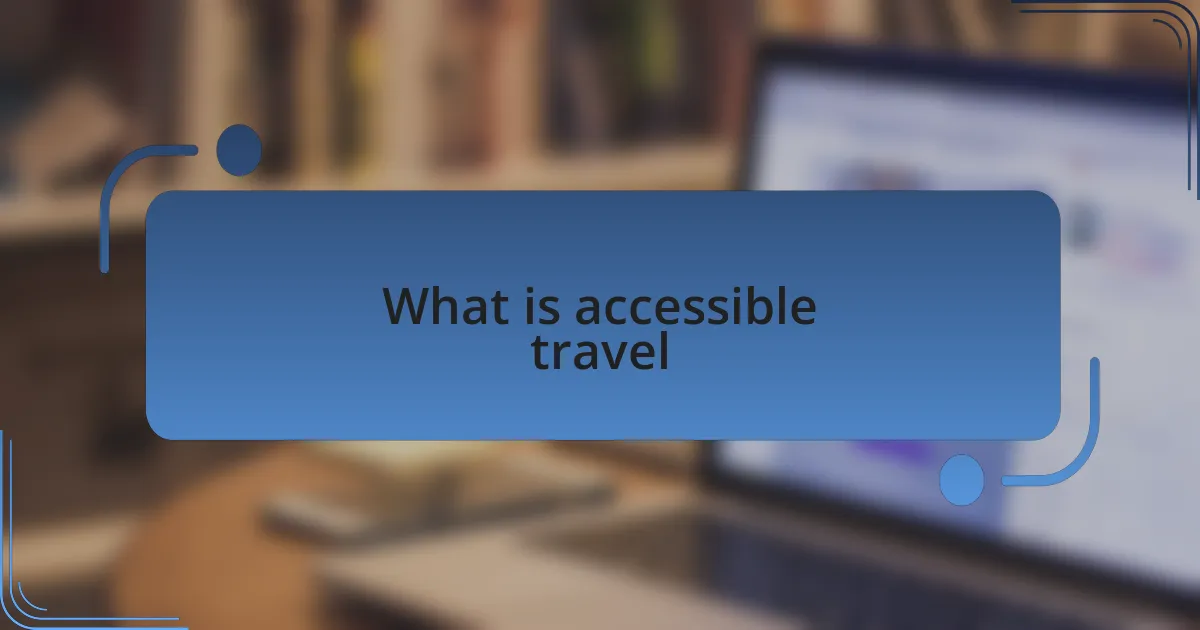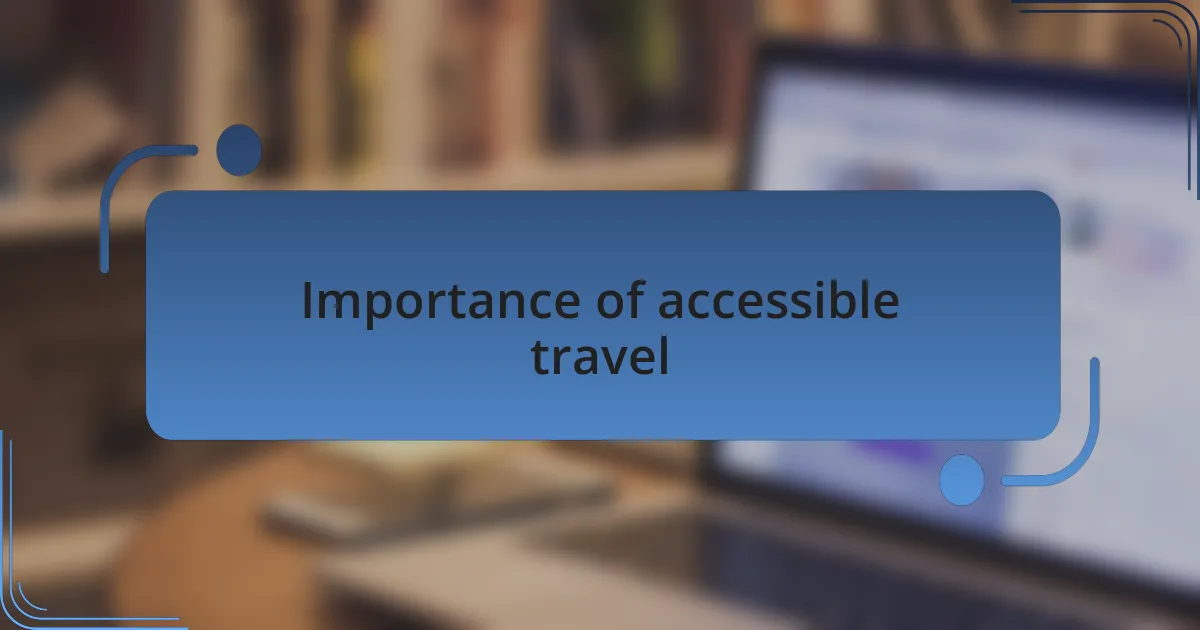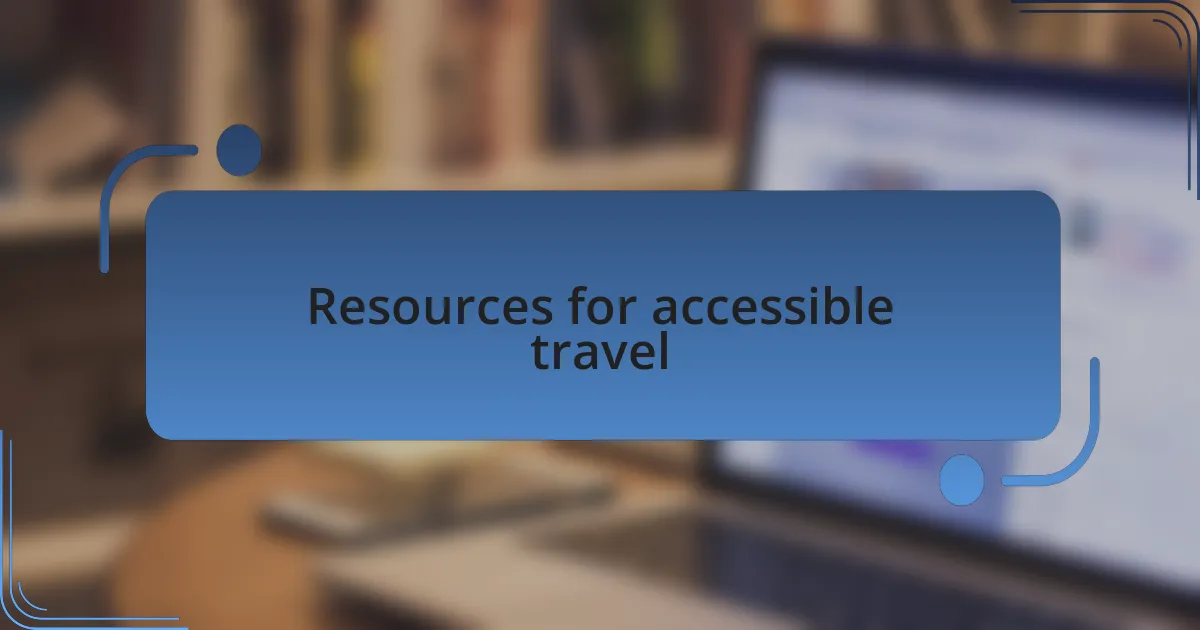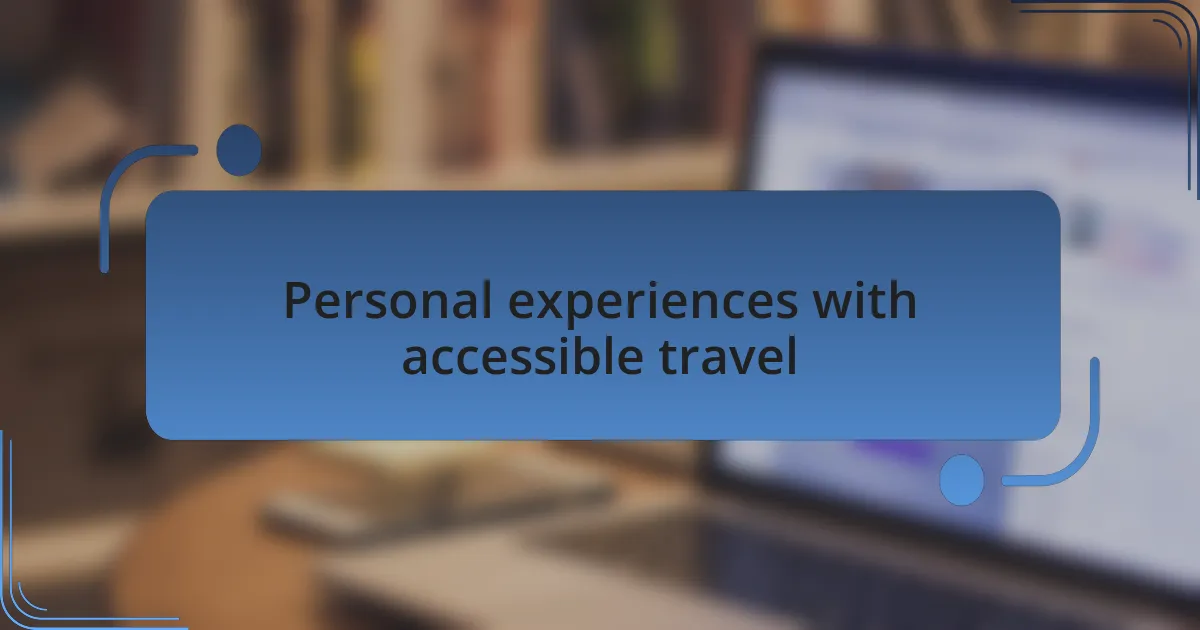Key takeaways:
- Accessible travel enhances experiences for individuals with disabilities by providing necessary accommodations and fostering inclusivity.
- Key principles include clear navigation, flexibility in design, and user-friendly environments that benefit all travelers.
- Common challenges include inadequate infrastructure and misrepresented accessible accommodations, emphasizing the need for thorough research when planning trips.
- Utilizing resources like blogs, social media, and accessibility-focused apps can significantly improve travel experiences for those with disabilities.

What is accessible travel
Accessible travel refers to the practice of ensuring that destinations, accommodations, and transportation are designed to accommodate individuals with diverse needs. I always find it remarkable how a few thoughtful adjustments can transform a travel experience, making adventure accessible for everyone. For instance, have you ever considered how a simple ramp can open up an entire world of exploration for someone who might otherwise be limited?
It’s more than just wheelchair ramps and elevators. Accessible travel addresses the myriad of physical, sensory, and cognitive challenges people face. I remember a trip where I encountered an amazing hotel that provided braille menus and trained staff to assist guests with disabilities. It struck me how such attention to detail could elevate the travel experience and foster a sense of inclusion. Isn’t it fascinating to think about how these little things can make all the difference?
When we talk about accessible travel, it’s essential to consider the perspectives of those with disabilities. I’ve spoken with friends who shared how vital it is for them to travel without extra barriers. Their stories highlight not just the challenges they face but also the joy that accessible travel can bring. This is about creating opportunities for adventure and connection, allowing everyone to experience the world fully and freely.

Importance of accessible travel
Accessible travel is crucial because it empowers individuals with disabilities to enjoy enriching experiences like anyone else. I once accompanied a friend who uses a wheelchair on a cross-country trip. Witnessing their sheer joy exploring national parks with adapted trails reminded me how accessibility opens doors to nature and adventure that many often take for granted.
Moreover, accessible travel fosters a sense of community and shared experiences. I fondly recall visiting a museum that had specialized programs for people with hearing impairments. The enthusiasm from everyone participating was contagious, and it made me realize how inclusivity not only enhances individual experiences but also enriches the interactions among diverse groups of people. Isn’t it wonderful to think that creating accessible spaces can bring us closer together?
Finally, the importance of accessible travel extends beyond just the individuals who benefit directly; it has significant implications for the tourism industry as a whole. Businesses that prioritize accessibility can tap into a wider customer base and enhance their reputation. In my experience, when I see hotels and attractions emphasizing inclusivity, it shows their commitment to hospitality. Don’t we all want to be part of a world that values every traveler?

Key principles of accessible design
When it comes to accessible design, one of the key principles is providing clear navigation. I remember visiting a city where the signage was intuitive and easy to read, regardless of mobility or sensory abilities. It made me think about how crucial it is for everyone to feel confident in finding their way, as getting lost can be frustrating and sometimes even dangerous for individuals with disabilities. Isn’t it amazing how a simple change in design can create such a welcoming environment?
Another fundamental aspect is ensuring flexibility in use. Take, for example, an art gallery I visited that offered various sensory experiences, allowing visitors to engage in different ways. This adaptability not only catered to individuals with disabilities but also enriched the experience for all attendees. It made me wonder: why shouldn’t every space strive for this type of inclusivity?
Furthermore, simplicity and intuitiveness in design are essential for accessibility. I once encountered an accessible website that effortlessly guided users through its features, making it enjoyable for everyone. The straightforward layout reminded me that accessibility shouldn’t feel like an afterthought but rather a core design principle. It’s a powerful reminder that when designs prioritize ease of use, everyone benefits, don’t you think?

Common challenges in travel accessibility
Traveling can often become a complex puzzle for individuals with disabilities. I remember a trip where I faced unexpected barriers at a train station: the elevator was out of order, forcing me to navigate a series of stairs. This experience underscored how easily a lack of infrastructure can transform an exciting journey into a stressful ordeal. Why should anyone’s adventure be hindered by something as fundamental as reliable access?
Another challenge lies in the variance of accommodations. During a hotel stay, I found out that the “accessible room” wasn’t as accommodating as I had hoped; there were narrow doorways and insufficient space to maneuver. It really struck me how important it is for travel providers to understand the actual needs of disabled travelers. Isn’t it frustrating when what’s labeled as accessible falls short of basic requirements?
Moreover, surface conditions can severely affect travel experiences. On one trip, I attempted to navigate through cobblestone streets, and it was far from easy. That jarring experience made me realize that even the most picturesque locations often overlook accessibility. It’s disheartening to think that the beauty of a place can be marred by such a simple oversight. Don’t you think every destination deserves to be enjoyed by everyone, regardless of mobility challenges?

Tips for planning accessible trips
When planning accessible trips, I often find it invaluable to research destinations beforehand. On one occasion, I scoured online resources and called the venues directly to confirm their accessibility features, only to discover that a popular tourist spot was actually quite difficult to navigate. Isn’t it surprising how much clarity you can gain from a simple phone call?
I always recommend creating a detailed itinerary that highlights accessible routes and transportation options. For example, during a recent visit to a city, I mapped out all the wheelchair-accessible bus stops and parking areas in advance. This thorough approach made my journey smoother and eliminated the stress of last-minute decisions. Have you ever experienced that sense of security that comes from being prepared?
Additionally, connecting with local disability organizations can be a game-changer. I remember reaching out to a local group before my last trip, and they provided me with invaluable insights about accessible attractions and hidden gems. It’s incredible how local knowledge can enhance your travel experience, isn’t it? Engaging with those who understand the landscape can pave the way for a more enjoyable adventure.

Resources for accessible travel
When it comes to resources for accessible travel, I’ve found that blogs dedicated to disability-friendly experiences can be a goldmine. On one occasion, I stumbled upon a blog where travelers shared their firsthand experiences navigating various destinations. I still remember the sense of relief I felt reading someone else’s adventures; their recommendations transformed my itinerary from daunting to doable. Have you ever felt that sense of kinship when you read someone’s story that mirrored your own challenges?
Another valuable resource is social media platforms, where groups focus on accessible travel. I joined a Facebook group, and the wealth of shared experiences was astounding. Members posted everything from hotel reviews to tips on accessible dining spots, which ultimately helped me feel more confident planning my trips. The support I received reminded me how powerful community can be—don’t you think it’s comforting to know others are traversing the same journey?
Lastly, I always advocate for utilizing apps specifically designed for accessibility. During a recent trip, I relied on an app that detailed accessible routes and offered real-time updates on transportation options. It was a relief to have that kind of information at my fingertips. Isn’t it amazing how technology has transformed our travel experiences, making them more inclusive and navigable?

Personal experiences with accessible travel
I remember my first solo trip to a major city, where I encountered unexpected challenges related to accessibility. While navigating public transport, I faced barriers that made me feel isolated and frustrated. I can’t forget the moment I found a staff member willing to help, which instantly shifted my mood from anxiety to relief. Have you ever felt a small act of kindness completely change your day?
On another trip, I booked an Airbnb that claimed to be accessible, only to find numerous steps leading to the entrance. The initial disappointment was palpable, making me reevaluate my choices in accommodations next time. This experience taught me the importance of asking specific questions before booking—are there any unanticipated obstacles that I should be aware of? It’s incredible how a little communication can save a lot of stress later on.
I also had the opportunity to join a guided tour specifically catering to travelers with disabilities. The guide was not only incredibly knowledgeable about the local sights but also adept at ensuring everyone’s comfort. That experience gave me a sense of belonging that I hadn’t realized I was searching for. When was the last time you were on a trip and felt like every detail was perfectly tailored to your needs? It’s moments like these that remind me how enriching accessible travel can truly be.